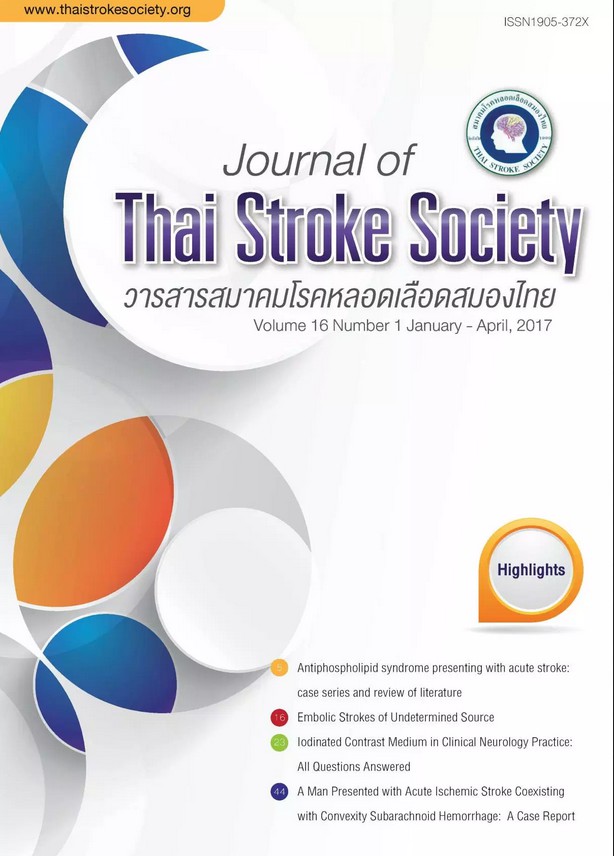A Man Presented with Acute Ischemic Stroke Coexisting with Convexity Subarachnoid Hemorrhage: A Case Report
Keywords:
intracranial arterial dissection, ischemic stroke, convexity subarachnoid hemorrhageAbstract
We reported an uncommon case of acute ischemic stroke with coexisting subarachnoid hemorrhage (SAH) in a 59-year-old man who presented with abrupt onset of right hemisensori-motor deficit without headache or prior head injury. Brain imaging study revealed acute infarcts of left middle cerebral artery (MCA) territory involving left middle frontal gyrus, left corona radiata and left posterior temporal lobe, SAH along left cerebral hemispheric sulci and gyri, and focal short segmental severe stenosis of left proximal part of MCA. Possible intracranial artery dissection with convexity SAH was diagnosed after vascular studies to exclude other differential diagnoses, such as central nervous system vasculitis (CNS vasculitis), reversible cerebral vasoconstriction syndrome (RCVS).
References
Neurol. 2015 Jun;14(6):640-54.
Jooseph F.G., Scolding N.J. Cerebral vasculitis: A practical approach. Pract Neurol. 2002 May;2: 80-93.
Wengenroth M., Jacobi C., Wildemann B. Cerebral vasculitis. In: Hähnel S, ed. Inflammatory Diseases of the Brain, Medical Radiology. Diagnostic
Imaging. Berlin, Heidelberg:Springer-Verlag; 2013;19-38.
Ducros A. Reversible cerebral vasoconstriction syndrome. Lancet Neurol. 2012 Oct;11(10):906-17.
Panicker J.N., Nagaraja D., Chickabasaviah Y.T. Cerebral amyloid angiopathy: a clinicopathological study of three cases. Ann Indian Acad Neurol. 2010
Jul-Sep;13(3):216-20.
Katoh M., Yoshino M., Asaoka M., et al. A restricted subarachnoid hemorrhage in the cortical sulcus in cerebral amyloid angiopathy: could it be a warning
sign? Surg Neurol. 2007 Oct;68(4):457-60.
Petridis A.K., Barth H., Buhl R., et al. Outcome of cerebral amyloid angiopathic brain haemorrhage. Acta Neurochir (Wien). 2008 Sep;150(9):889-95.
Mastaglia F.L., Byrnes M.L., Johnsen R.D., Kakulas B.A. Prevalence of cerebral vascular amyloid-beta deposition and stroke in an aging Australian
population: a postmortem study. J Clin Neurosci. 2003 Mar;10(2):186-9.
Fukuma K., Ihara M., Tanaka T., et al. Intracranial cerebral artery dissection of anterior circulation as a cause of convexity subarachnoid hemorrhage.
Cerebrovasc Dis. 2015;40(1-2):45-51.
Downloads
Published
How to Cite
Issue
Section
License
ข้อความภายในบทความที่ตีพิมพ์ในวารสารสมาคมโรคหลอดเลือดสมองไทยเล่มนี้ ตลอดจนความรับผิดชอบด้านเนื้อหาและการตรวจร่างบทความเป็นของผู้นิพนธ์ ไม่เกี่ยวข้องกับกองบรรณาธิการแต่อย่างใด การนำเนื้อหา ข้อความหรือข้อคิดเห็นของบทความไปเผยแพร่ ต้องได้รับอนุญาตจากกองบรรณาธิการอย่างเป็นลายลักษณ์อักษร ผลงานที่ได้รับการตีพิมพ์ในวารสารเล่มนี้ถือเป็นลิขสิทธิ์ของวารสาร





